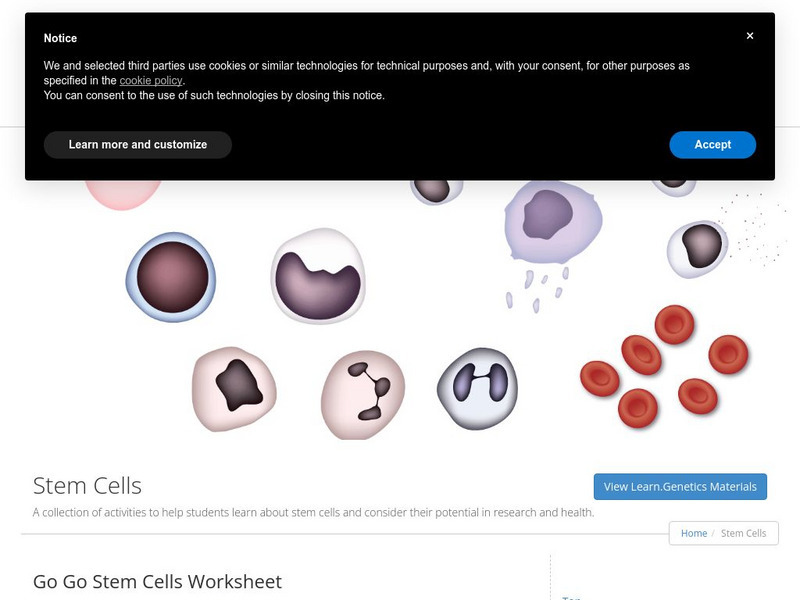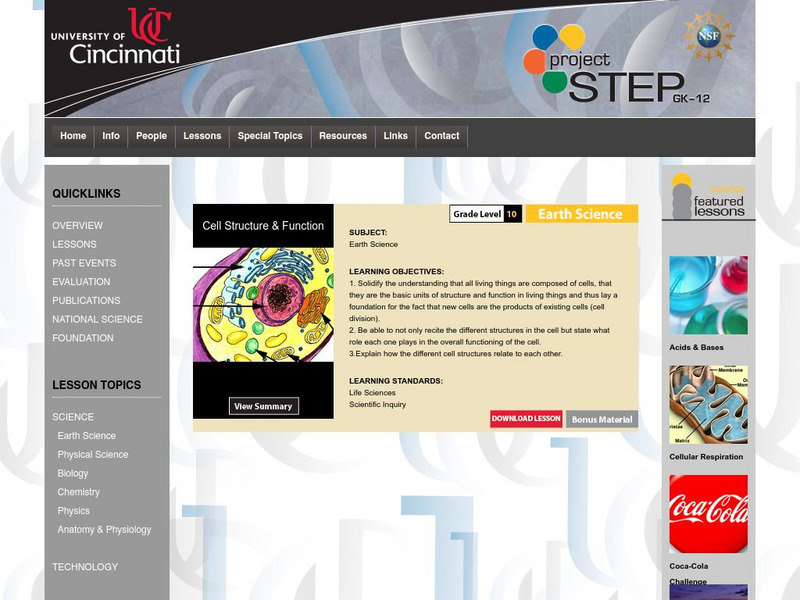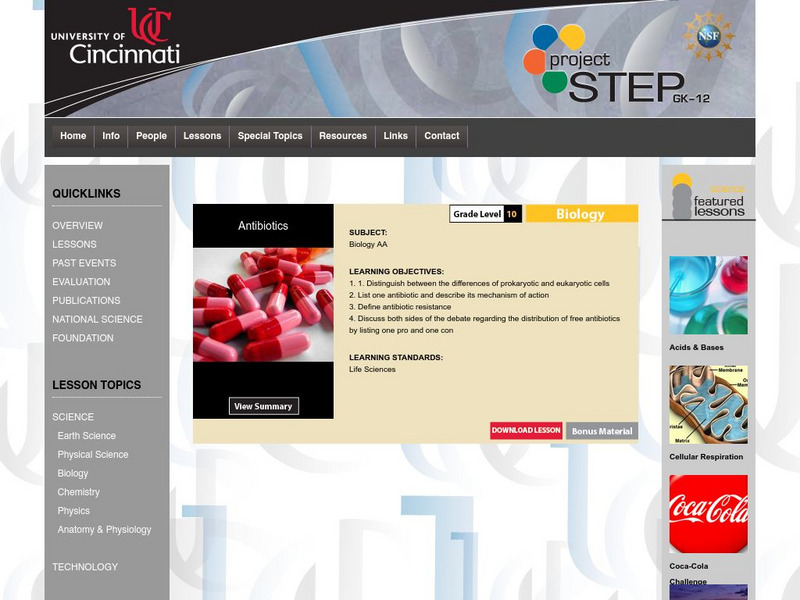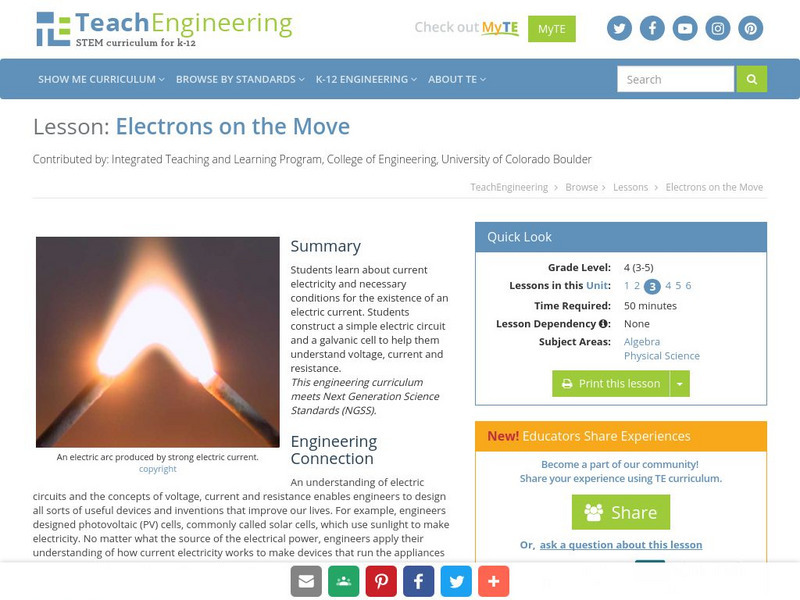Hi, what do you want to do?
Curated OER
Science Processes
Fifth graders observe a dry piece of bread and a damp piece of bread in two separate sealed bags that have been sitting for several days that have been labeled. The observe the mold with a hand lens and record findings in their science...
Curated OER
From Vibration to Sound
Students observe a series of demonstrations to illustrate wave movement. In this sound wave lesson, students witness how objects create waves when dropped in a dish of water, use a rope and slinky to produce transverse and longitudinal...
Curated OER
Teen Smoking: Designing a School Anti-Smoking Publicity Campaign
Young scholars review the human respiratory system and the effects on the human body. In this design instructional activity students brainstorm and create a prototype then present it to the class.
Curated OER
Making a Human Tree
Students explore botany by defining the anatomy of a tree. In this environmental exploration lesson, students research plant vocabulary terms and discuss the uses of each word. Students create a "human" tree by role-playing as one of the...
Curated OER
Plant Biotechnology: Controlling Tissue Differentiation
Young scholars demonstrate hormonal control of plant tissue differentiation and relate this differentiation to gene expression. They explore the effects of hormones (auxin and cytokinin) on the genes that control tissue differentiation...
Curated OER
Plant Biotechnology: Controlling Tissue Differentation
Students demonstrate skills of biotechnology stringent aseptic technique and statistical analysis. They describe hormonal control of plant tissue differentiation and relate this to gene expression. Students observe the effects of...
Curated OER
Vegetable Twister
Young scholars review vegetables and their nutrient values and production. In this vegetable production worksheet, students read information about the nutrients in vegetables and how they are grown. Young scholars participate in a game...
Curated OER
GPS Receiver Basics
Students practice using a GPS receiver. They walk in different directions and monitor their progress on maps. They enter specific locations and use information given to them to get them back to their original locations.
Curated OER
Generators: Three Mile Island vs. Hoover Dam
Students are given a history of electricity and its development into the modern age lifeline upon which we so depend. The methods of power generation are introduced, and further discussion of each technology's pros and cons follows. ...
Curated OER
Reflexes
Students experiment to explain how reflexes, nerve impulses travel to the brain.
University of Utah
University of Utah: Genetic Science Learning Center: Which Type of Stem Cell Would You Use?
A teacher guide and student handout for a lesson where students must weigh the advantages and disadvantages of using different types of stem cells to treat diabetes, Parkinson's Disease, heart disease, and lupus. They also compare gene...
PBS
Pbs Teachers:stem Cell Research Policy Lesson Plan: Create an Advocacy Brochure
Research the science and controversy around stem cell research and evaluate, defend or attack President Bush's ruling on federal spending regarding this issue. Create brochures to display knowledge and point of view.
TeachEngineering
Teach Engineering: The Cloning of Cells
Students continue their education on cells in the human body. They discuss stem cells and how engineers are involved in the research of stem cell behavior. They learn about possible applications of stem cell research and associated...
TeachEngineering
Teach Engineering: Cell Celebration!
Young scholars look at the components of cells and their functions. The lesson focuses on the difference between prokaryotic and eukaryotic cells. Each part of the cell performs a specific function that is vital for the cell's survival....
Other
University of Cincinnati: Project Step: Cell Structure and Function
Engaging, interactive lesson focusing on cells being the basic units of structure and function of all living things. Students will be able to explain the different roles of each structure and how they relate to each other.
TeachEngineering
Teach Engineering: Cell Membrane Structure and Function
Young scholars learn about the different structures that comprise cell membranes, fulfilling part of the Research and Revise stages of the legacy cycle. Students view online animations of cell membrane dynamics (links provided). Then...
PBS
Pbs Teachers: Scientific American: Never Say Die: How to Make a Nose
Investigate breakthroughs in stem cell research, and explore the structure and function of a DNA molecule. Create a model of a DNA from tagboard.
Other
Ohio Department of Education: Cell Division and Differentiation
In this lesson, students use hands-on activities and journaling to learn about the process of mitosis, meiosis and cell differentiation. Hands-on activities include modeling of the mitosis and meiosis processes with model building and...
PBS
Pbs Teachers: Scientific American: Body Building: Encouraging Cell Growth
Investigate medical research in producing (culturing) artificial organs, such as livers, on silicon chips. Test how the surface coating of a substrate affects the success of a biofilm.
Other
University of Cincinnati: Project Step: Antibiotics
STEM biology lesson where by designing their own antibiotics, students will gain an understanding of how the differences between prokaryotic cells and eukaryotic cells have played a role in their own health. They will also be able to...
Other
The Plant Cell: Teaching Tools in Plant Biology: Why Study Plants?
Plants are essential for all life and development. Teach your students about this incredible lifeforce with this teaching guide, lecture notes, and PowerPoint presentation. [PDF]
TeachEngineering
Teach Engineering: Electrons on the Move
Students learn about current electricity and necessary conditions for the existence of an electric current. Students construct a simple electric circuit and a galvanic cell to help them understand voltage, current and resistance.
Science Buddies
Science Buddies: Explore Enzyme Activity
In this science activity, you will investigate the enzyme called catalase to find out how it helps to protect your body from cell damage.
Other popular searches
- Cell Biology Stem Cells
- Human Stem Cells
- Bioethics of Stem Cells
- Ethical Issues Stem Cells
- Stem Cells Genetics
- Embryonic Stem Cells
- Debates Stem Cells
- Benefits of Stem Cells
- Stem Cells Lesson Plans
- Animal Plant Cells Stem
- Stem Cells for Plannet
- Stem Cells for Plan Net


























